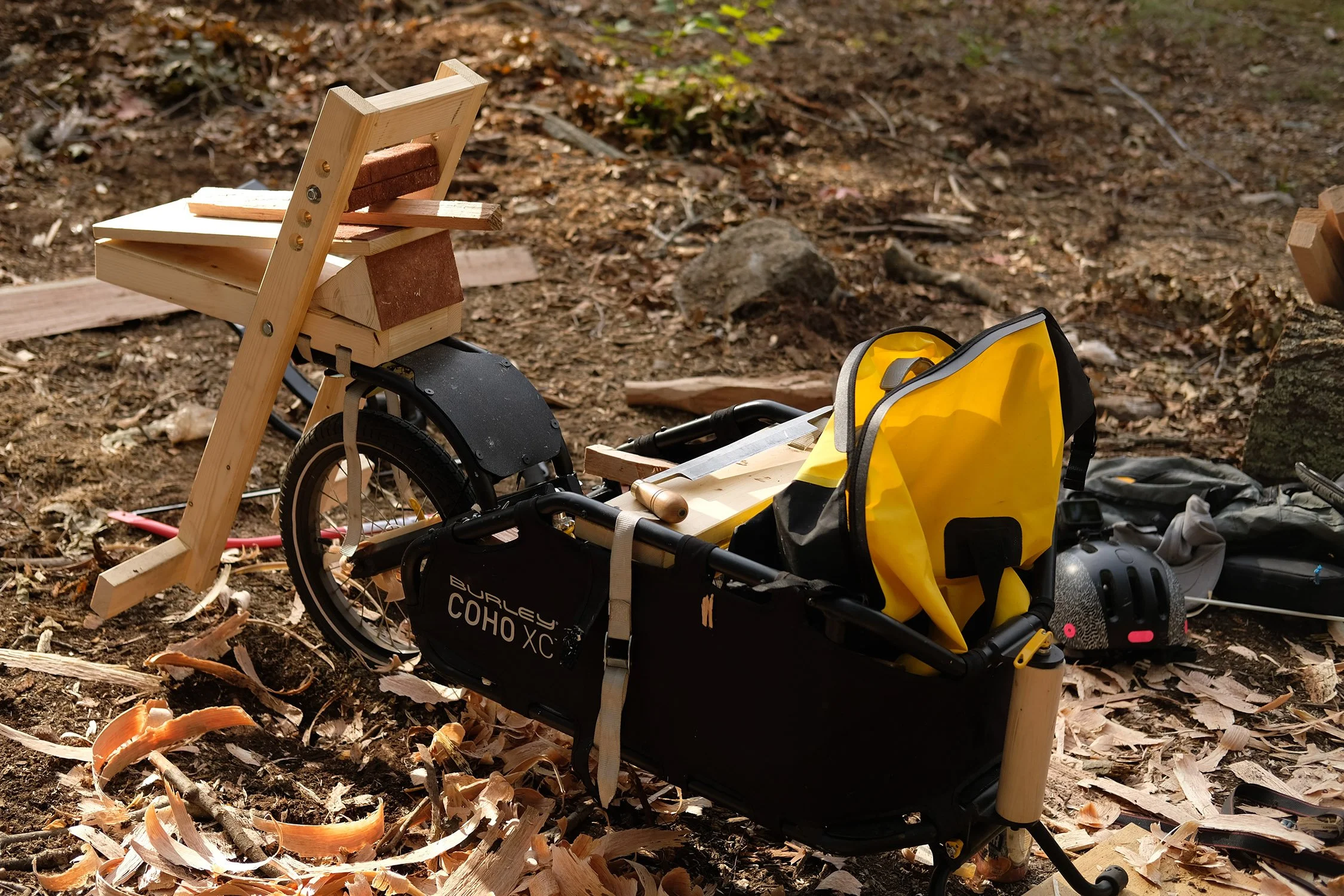Counting Calories_ Background
The chainsaw fells. The loader piles. The truck transports. The mill gives order. The kiln dries. The fork lift stacks. The truck delivers…again, and probably again, and again. My car makes a special trip to the lumber yard and back to my shop. The machines flatten, dimension, shape, and turn…all for the log to become round once more.
There are 31,000 Calories in one gallon of gasoline. One horsepower is equal to the consumption of 641 Calories per hour. For a moderately active man my age, it is suggested I consume between 2,400 and 2,600 calories a day…in reality, I could probably survive on far fewer.
The night before my first big day of Counting Calories, as I gathered up my tools, and finished the last few details to make my jigs and fixtures functional, I struggled with the fact that my Mobile Manual Log Processing Unit (MMLPU) had been built using more energy than the sum total of all the chairs it will ever help create. The task of ‘treading lightly’ had already begun to show its paradoxical truth.
What I had deemed the most appropriate log for my tight schedule lay amongst a massive pile of trunks and branches of lesser quality, all of which had been cut down to make room for a new patio in the backyard of a home in Cranston.
I came across this lot of chair making material listed as firewood on Facebook marketplace, and on my initial scouting trip the week prior, had chosen my candidate. An eight foot long, fourteen inch in diameter Red Oak log, weighing multiple times my own weight. It just so happened to be way up on the top of the pile.
The first day of Counting Calories started with a cup of coffee, a quick shower, and a double checking of my tool inventory. I turned my bike around, noting tight turns with the trailer can be treacherous, swung my right leg over my top tube, and took off on the eight mile trek, MMLPU in tow, to the location of the log that would soon become chair.
Passing the Stop & Shop about a half of the way into my ride, I noticed I’d forgotten one important ingredient on my food fueled wood processing exploit...food. A quick pitstop to grab some, and I was back at it.
As I struggled up Phenix Ave., an all too familiar quick little flick of my right index finger revealed what I was afraid would become the theme of the day...I was out of gears. A few more minutes of struggle, and a bout of huffing and puffing, and I had made it to the log, the pile on which it lay, and my worksite for the day.
Over the course of this long, beautifully sunny Sunday in October, I climbed to the top of the pile, and split the log while it lay in situ being careful not to roll an ankle or roll the log onto myself. I heaved the split log off the top of the stack, quartered it, cut it to a variety of lengths, rived these lengths down closer to their final dimensions and shaved the components down even closer yet. I stacked the wood I would not use, being careful to be respectful of the property owner, gathered the chips into the MMLPU’s dry bag, and transported the fruit of the day’s labor via bicycle and trailer, back to my house over three long, slow, fulfilling round trips.
On this most demanding day of the creation of Counting Calories, I consumed 4,511 Calories, which entered my body as an Italian sub, dried cranberries, a 20 oz. Coke, spaghetti, a salad, and hopefully some fat clinging to me from the past.
Thirty-two miles on a bike weighed down with a variety of tools, the MMLPU, 22 rough chair components including redundancies, and all of the waste left over both to fuel my wood steamer, and clean the site. 4,511 Calories, 2,500 of which I would have consumed anyhow, and I have the beginnings of a chair, made from a tree whose prior fate had been the wood chipper.
My first four concessions would yield the largest efficiencies:
I could not use my car or any fossil-fueled transportation. I opted instead for the most efficient means: the bicycle. Pulling my Burley trailer, I could move decent size loads with a bit of effort, but little energy use. Not only was I to use what I had figured to be a more efficient source of energy, but I would not be wasting excess on moving the mass of my 2 ton Ford Transit Connect.
I could not use milled and kiln-dried lumber. The energy intensive and inefficient diesel of the mill and natural gas of the kiln mandated the wood be processed under my own power. I would split the chair components from a red oak log, felled a few weeks prior to clear land for a new patio the south of Cranston.
I would have to make the seat from plant matter I could easily find in my near surroundings. For no reason beyond preference, I opted for a woven seat. The materials used in contemporary times for this application are those of import. But the cattail, a grass native to New England found along the shores of its many ponds and swamps, makes for fine, but laborious weaving.
And lastly, to make the chair frame material more moveable and manageable, I would have to work the log down as much as possible in-situ, in order to avoid using energy transporting material which would not turn into chair.





